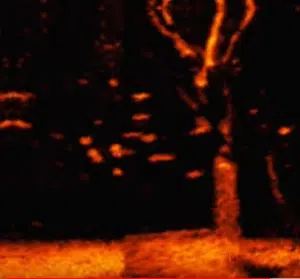WE ARE YOUR SOURCE FOR FISHING DESTINATIONS IN ALABAMA!
Lessons Learned with Live Sonar

You don’t have to have live sonar to apply many of these lessons learned by Alabama’s anglers to your own fishing.
By Eileen Davis
I will add to this page as anglers share more of their observations. Subscribe and I will let you know when new information is posted.
♦ Learn to determine fish size by never changing the range and depth on your unit. For example, I keep my range set to 50 feet and the depth to 20 feet. Shiloh Shoppell, Winning Tournament Angler and Guide
♦ At times, we are see really big fish spook 40 feet from the boat. – Brandon Threadgill, Winning Tournament Angler
♦ One downside to LiveScope is spending too much time on fish that will not bite when you have normally moved to fish the next spot. – Brandon Threadgill, Winning Tournament Angler
♦ The most important information from live sonar is how fish react to different lures. Whether it’s just a color change or a different lure, when you find what they really want, bass will attack from nowhere. That is when you know your have found the right bait. – Logan Parks, Bass Pro Shops U.S. National Bass Fishing Amateur Team Champion
♦ Before ActiveTarget, I would make one or two casts to a brush pile and move on. Now, when I see a bass on brush pile, I’ll make a fast retrieve with a jerkbait trying to get a reaction strike. If that does not work, I’ll make another cast with the same lure and stop it by the brush pile. Sometimes 10 seconds will elapse before the fish will come off the bottom to take the lure. – Dallas Weldon, Alabama Bass Trail Angler of the Year
♦ When I am fishing with a drop shot or a spoon on the bottom 40 feet deep and see a fish on ActiveTraget suspended at 10 or 15 feet, I will quickly reel my lure to that level. These are active fish and they are aggressive. You will catch every one of them. By the time you would have seen these fish on traditional sonar, they would have already swam through the narrow cone. – Dallas Weldon, Alabama Bass Trail Angler of the Year
♦ To find and catch bass offshore in fall and winter, use side scan sonar to locate a school of baitfish, then follow the shad using live sonar at a distance of 40 to 60 feet. In no time, a group of predatory bass will appear. It’s like watching a pack of wolves move onto a pasture with livestock. A suspending jerkbait or a swimbait will do the trick. – Eileen Davis, National Fishing Champion
♦ When threatened by bass, shad instinctively form into a tight ball. A densely packed bait ball is a sure indication bass are nearby. – Eileen Davis, National Fishing Champion
♦ Regardless of the species, if you see a fish 40 feet away that you want to catch, you need to know how far 40 feet is from the boat. It’s essential to the type of presentation you want to make. I found I was casting too far and wasting valuable fishing time. To help me with casting distance accuracy, I marked my braid with different colored Sharpies at 10 foot intervals. After a few days of fishing, this is no longer necessary. – Eileen Davis, National Fishing Champion
♦ If you see a school of crappie on a tree, look around using LiveScope. Often a big fish will suspend off to the side of the school. He will not be in that mix. Using LiveScope, you can target big fish. – Blake Phillips, Eye Hole Jig Owner/Inventor
♦ The depth of crappie depends on ambient light and water clarity. With LiveScope, when the sun comes up you can see them move down the tree and even into the root system or the branches where the tree has fallen down. Though, even on sunny days, some fish will suspend about 6 feet deep. – Blake Phillips, Eye Hole Jig Owner/Inventor
♦ Before LiveScope, we would catch 10 fish from a brush pile, and they would stop biting. We would often say that we caught them all. Now that we can see those fish, we know they sometimes go down and bury in the brush. If you stay there, they will come back up, suspend, and you can catch them again. – Eric Cagle, National Fishing Champion and Guide
♦ In late fall and winter, if you catch a few fish, the school will follow those fish. They will roam for a little while, and then, they will return to the brush. Before, we would leave, now if you are patient, you can actually catch more fish. – Eric Cagle, National Fishing Champion and Guide
♦ The biggest advantage to LiveScope is time management. When you see a stump or brush pile that looks good, you can check it with LiveScope and determine without a doubt whether or not it holds fish. – Kevin McCarley, Winning Tournament Angler
♦ The main thing I’ve learned from using LiveScope is how many fish look at your bait and never bite. It is amazing! – Kevin McCarley, Winning Tournament Angler
♦ Crappie have a definite choice of the color of the bait they want from day to day. It obvious watching them with LiveScope react to different colors. – Eileen Davis, National Fishing Champion
♦ My trolling motor spooks keeper size crappie if I get closer than 25 feet. Any movement on the boat that creates noise has the same effect. – Eileen Davis, National Fishing Champion
♦ I have also watched many fish spook 20 to 30 feet from the boat. It could be the boat’s shadow, the trolling motor or something else. Most of the time the fish go to the bottom. Wait him out and he will come back up, and that is when you can catch him. – Kevin McCarley, Winning Tournament Angler
♦ On cold winter bright sunny days, some crappie will warm themselves within 2 feet of the surface in the afternoon. – Eileen Davis, National Fishing Champion
♦ Bass and crappie often follow your lure on the fall or while being retrieved. Their curiosity doesn’t mean they will strike. Although, they sometimes will if you pause the lure or change direction. – Eileen Davis, National Fishing Champion
♦ Your best bet of getting bit is to work your lure though a group of fish. Often, the strike is more about competition than feeding. – Eileen Davis, National Fishing Champion
Read more about how successful anglers find and catch Bama’s fish.
PLEASE SHARE

